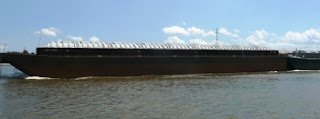Here is a picture of the first Asian carp that through himself (herself?) in the dinghy. We weren't so charmed by the next three kamikaze carp, didn't take their pictures.
 |
| Dead carp |
The wicket dams can change the depth of the water by 10 or more feet. Of course, the depth of the water changes many times over the course of a single year. We came down the coast of Michigan slowly because the rivers were flooding in May and June. By the time we got to the Mississippi the river was low. When you get to the southern end of the Illinois and the the Mississippi you really understand how much the river levels change. These houses are on the banks of the Mississippi and they are raised two full stories from the ground to the first floor.
 |
| River houses |
Even the trees have to deal with the rising and lowering of the water. This tree is in the pool of one of the wicket dams. You can see the line in the tree that marks where the water is when the dam is raised.
This is one barge in a Mississippi tow. Imagine a tow with 8 or 9 of these in a row and 3 or 4 rows lashed together. We are still going to be dealing with tows on the Tennessee River and the Tombigbee waterway, but they won't be as big as the Mississippi River tows.
 |
| Mississippi barge |
St. Louis has the worst waterfront of any water front city I have seen. I thought Cleveland had wasted its water front but it has nothing on St. Louis. That "beach" you see in front of the arch is a parking lot. Of course, with all the commercial barge traffic on the Mississippi, and the cities upstream who pump their waste into the river, you wouldn't want to swim in the Mississippi anyway.
We've just come back to the boat after going home to Cleveland for a couple of weeks. Saturday our friends the Harrises arrive for a week's visit and we will start heading up the Tennessee River towards Knoxville.



